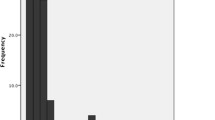Abstract
To evaluate the demographics and treatment of facial lacerations occurring in a paediatric patient cohort. We undertook a prospective study of 106 children who sustained a soft tissue facial injury and who presented to an Accident and Emergency department in a UK district general hospital supporting a population of 750,000. Approximately 31,000 are dependent children between the age of 0–12 years. Our results show that the majority of paediatric patients who sustained a facial laceration were male (62%). The frequency of this injury was greatest amongst males across all age groups. The majority of children above 3 years of age sustained their injury outdoors. The peak time for injury varied for different age groups. The 0–3 year olds sustained the highest incidence of injuries around 17:00 h. A bi-modal time pattern was seen in the 4–6 year age group, initially at 12:00 h with a second peak at 17:00 h. The most frequent aetiology was play. A significant finding was that 8% of the injuries that were managed resulted from a dog bite. Almost 50% of children above 4 years of age, who required primary closure of their laceration, were able to tolerate their treatment being performed under local anaesthesia. The pattern of facial lacerations in our study supports the results of previous studies. Our data has provided further insight into the presentation of these injuries. These studies are valuable in targeted injury prevention programmes aimed at potentially reducing the nature, incidence and severity of facial soft tissue trauma in children in the UK.





Similar content being viewed by others
References
Brown RD, Cowpe JG (1985) Patterns of maxillofacial trauma in two different cultures. A comparison between Riyadh and Tayside. J R Coll Surg Edinb 30(5):299–302
Gassner R, Tuli T, Hachl O, Rudisch A, Ulmer H (2003) Cranio-maxillofacial trauma: a 10 year review of 9,543 cases with 21,067 injuries. J Craniomaxillofac Surg 31(1):51–61
Metzinger SE, Rigby PL, Simmons MJ, Boyce RG (1994) An epidemiologic study of maxillofacial trauma at University Medical Center in Lafayette, a regional referral center. J La State Med Soc Mar 146(3):101–104
Gassner R, Bosch R, Tuli T, Emshoff R (1999) Prevalence of dental trauma in 6000 patients with facial injuries: implications for prevention. Oral Surg Oral Med Oral Pathol Oral Radiol Endod 87(1):27–33
Smith J, Maconochie I (2003) Should we glue lip lacerations in children? Arch Dis Child 88(1):83–84
Mattick A (2002) Use of tissue adhesives in the management of paediatric lacerations. Emerg Med J 19(5):382–385
Parlin LS (1997) Repair of lip lacerations. Pediatr Rev 18(3):101–102
Sibert JR, Maddocks GB, Brown BM (1981) Childhood accidents—an endemic of epidemic proportion. Arch Dis Child 56(3):225–227
Baker MD, Lanuti M (1990) The management and outcome of lacerations in urban children. Ann Emerg Med 19(9):1001–1005
Rivara FP, Bergman AB, LoGerfo JP, Weiss NS (1982) Epidemiology of childhood injuries II. Sex differences in injury rates. Am J Dis Child 136(6):502–506
Liebelt EL (1997) Current concepts in laceration repair. Curr Opin Pediatr 9(5):459–464
Shaikh ZS, Worrall SF (2002) Epidemiology of facial trauma in a sample of patients aged 1–18 years. Injury 33:669–671
Hutchison IL, Magennis P, Shepherd JP, Brown AE (1998) The BAOMS United Kingdom survey of facial injuries part 1: aetiology and the association with alcohol consumption. British Association of Oral and Maxillofacial Surgeons. Br J Oral Maxillofac Surg 36(1):3–13
Gassner R, Tuli T, Hachl O, Moreira R, Ulmer H (2004) Craniomaxillofacial trauma in children: a review of 3,385 cases with 6,060 injuries in 10 years. J Oral Maxillofac Surg 62(4):399–407
McGraw BL, Cole RR (1990) Pediatric maxillofacial trauma. Age-related variations in injury. Arch Otolaryngol Head Neck Surg 116(1):41–45
Baker MD, Selbst SM, Lanuti M (1990) Lacerations in urban children. A prospective 12-January study. Am J Dis Child 144(1):87–92
Tarantino CA, Dowd MD, Murdock TC (1999) Short vertical falls in infants. Pediatr Emerg Care 15(1):5–8
Stewart G, Meert K, Rosenberg N (1993) Trauma in infants less than three months of age. Pediatr Emerg Care 9(4):199–201
Reece RM, Sege R (2000) Childhood head injuries: accidental or inflicted? Arch Pediatr Adolesc Med 154(1):11–15
Karlson TA (1984) The incidence of facial injuries from dog bites. JAMA 251(24):3265–3267
Chapman S, Cornwall J, Righetti J, Sung L (2000) Preventing dog bites in children: randomised controlled trial of an educational intervention. Br Med J 320(7248):1512–1513
Ong TK, Dudley M (1999) Craniofacial trauma presenting at an adult accident and emergency department with an emphasis on soft tissue injuries. Injury 30:357–363
Bamjee Y, Lownie JF, Cleaton-Jones PE, Lownie MA (1996) Maxillofacial injuries in a group of South Africans under 18 years of age. Br J Oral Maxillofac Surg 34(4):298–302
Iida S, Matsuya T (2002) Paediatric maxillofacial fractures: their aetiological characters and fracture patterns. J Craniomaxillofac Surg 30(4):237–241
Durkin MS, Kuhn L, Davidson LL, Laraque D, Barlow B (1996) Epidemiology and prevention of severe assault and gun injuries to children in an urban community. J Trauma 41(4):667–673
Author information
Authors and Affiliations
Corresponding author
Rights and permissions
About this article
Cite this article
Islam, S., Ansell, M., Mellor, T.K. et al. A prospective study into the demographics and treatment of paediatric facial lacerations. Pediatr Surg Int 22, 797–802 (2006). https://doi.org/10.1007/s00383-006-1768-7
Accepted:
Published:
Issue Date:
DOI: https://doi.org/10.1007/s00383-006-1768-7




